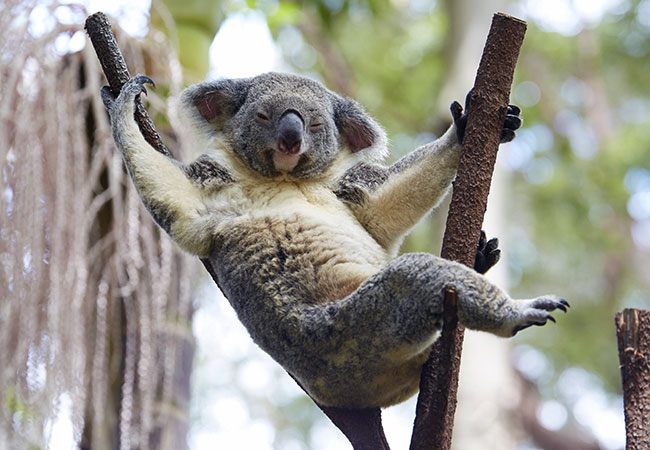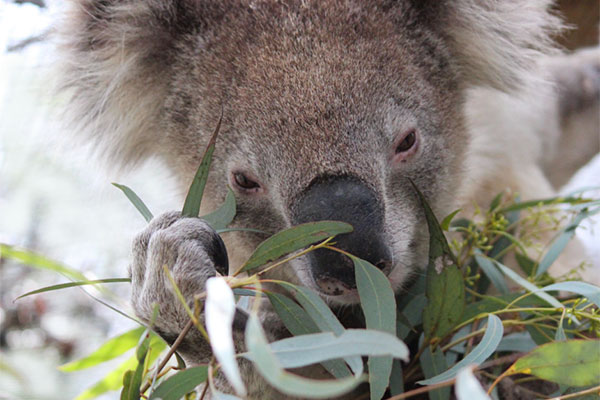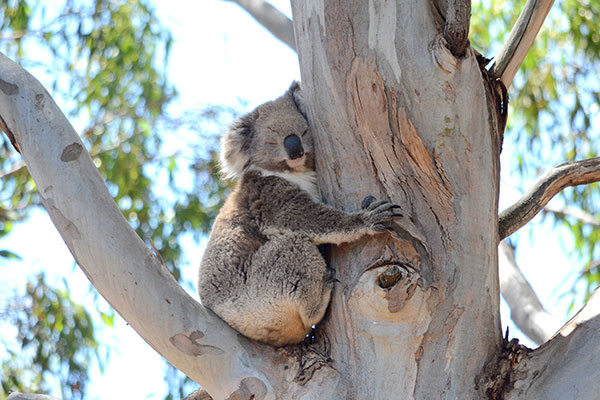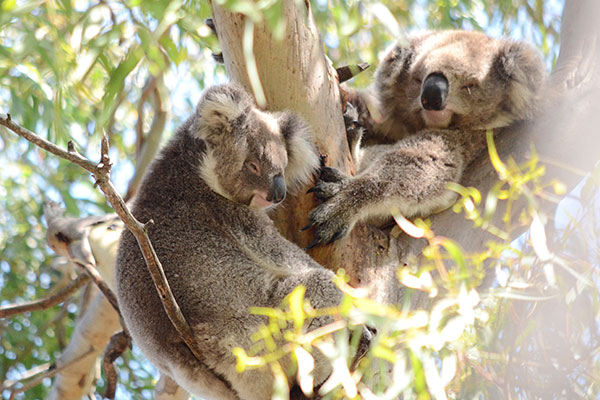5 Myths About Koalas
Guest post from Janine Duffy – Director of Marketing & Wildlife Research, Echidna Walkabout (Melbourne)
Koalas are so cute, they could be mythical creatures. Maybe that’s why there are so many popular myths about them. In honor of Wild Koala Day, coming May 3, here are 5 myths about koalas, debunked.
1. Koalas are drunk or high on eucalyptus

Image: Tourism Queensland
This is my favourite, and possibly one of the most popular myths in the animal kingdom. In fact, if you start typing into google, “are koalas…” the first option is, “are koalas high”!
The idea that humans are not the only species on the planet that get drunk or stoned is gratifying. That this intemperate animal should be Australian resonates with the world’s view of Australia: a land of friendly, sozzled creatures lazing about in the sun. But, it simply isn’t true.
Let me say it clearly: Koalas are not drunk on eucalyptus. There is no alcohol in eucalyptus to intoxicate them. They do rest a lot, but it’s not due to a hangover.
2. Koalas are slow
As a koala researcher, I almost wish this were true. Many times I have left a resting koala, just for 10 minutes, and returned to find they have completely disappeared. A koala can run on the ground at around 32kph, and if frightened, can leap up a tree in 2-metre bounds.
Koalas lead a slow lifestyle most of the time. They rest a lot, due to low nutritional value in their food. But when they move, they can be fast, agile, and powerful.
3. Koalas only eat one type of gum tree

Image: Echidna Walkabout Nature Tours
Koalas live all over eastern Australia and only eat one type of tree? Golly, it’s no wonder such a fussy animal is dying out.
Don’t fear—this myth is not true either. Koalas in the You Yangs near Melbourne have been recorded eating every one of the 15 species of eucalypt (gum tree) in the park. Throughout Australia, the gum trees they eat number in the hundreds of species.
This myth may have started from some early scientific research that showed that koalas have a high preference for certain species of eucalyptus in certain regions. That can be true in some places, but not in others. In the You Yangs, 34% of koala sightings are in river red gum trees. The rest of the time, they are in blue gums, yellow gums, ironbarks, sugar gums, red box, manna gums—you get the picture.
4. Koalas are docile and love to be petted and cuddled

Image: Echidna Walkabout Nature Tours
Koalas are wild animals. Like most wild animals, they prefer to have no contact with humans at all.
Two independent scientific studies—a 2014 University of Melbourne study and a 2009 study—found that even captive koalas, born and raised in a zoo, experienced stress when humans approached too close to them. In the wild, Echidna Walkabout Nature Tours have found that 10 metres is the closest you should ever be to a koala. Any closer, and the koala’s behaviour changes: they stop resting or feeding and they stare at you nervously.
Unfortunately for koalas, they look cute even when they’re terrified.
I’m not saying that a koala has never enjoyed being petted. We can only guess what they enjoy and what they don’t. A koala orphan being raised by a wildlife caretaker may enjoy being petted by their caretaker. But being petted by a stranger? All the evidence suggests that koalas do not enjoy that, and it may even be harming them.
Note from Down Under Endeavours: You will see on some of our packages that we sell a “Cuddle a Koala” experience where you can pose for a photo with a koala. However, the experience is under careful supervision by the koala’s caretakers. For the koalas’ wellbeing, the interactions are strictly limited in terms of time spent interacting and the number of interactions per day.
5. Koalas are so numerous they are hanging out of trees everywhere

Image: Echidna Walkabout Nature Tours
This is not true. Wild koalas are declining at a rate of 53% in Queensland, 26% in the small remaining population of New South Wales, and 14% in Victoria. That is why they are listed as vulnerable (one step before endangered) and the International Union for Conservation of Nature added them to the “Red List” of species worldwide most at risk from climate change.
This myth comes from 2 partial-truths. The first is historical: there was once a time when koalas were very plentiful across their range. But that time is long gone. The other partial-truth is current: There are 5 to 6 small pockets in southern Victoria and South Australia where koalas are overabundant, for reasons that are not understood, despite the research efforts of the best koala ecologists. These populations receive a lot of media and research attention, which makes them seem larger than they are.
The majority of these overabundant populations are in Victoria, yet the overall Victorian koala population is still declining at a rate of 14%—which suggests severe declines in the rest of Victoria.
This is why Australians are getting behind Wild Koala Day on May 3. Wild Koala Day is about connecting koalas with habitat protection. If we are all to enjoy koalas, we need them to survive in the wild, not just in captivity. Act now to save them. On Wild Koala Day, May 3, plant a tree, protect a forest, and phone a politician.
Want to see koalas and other Australian animals in the wild? Discover our Top 10 Australian Wildlife Tours.